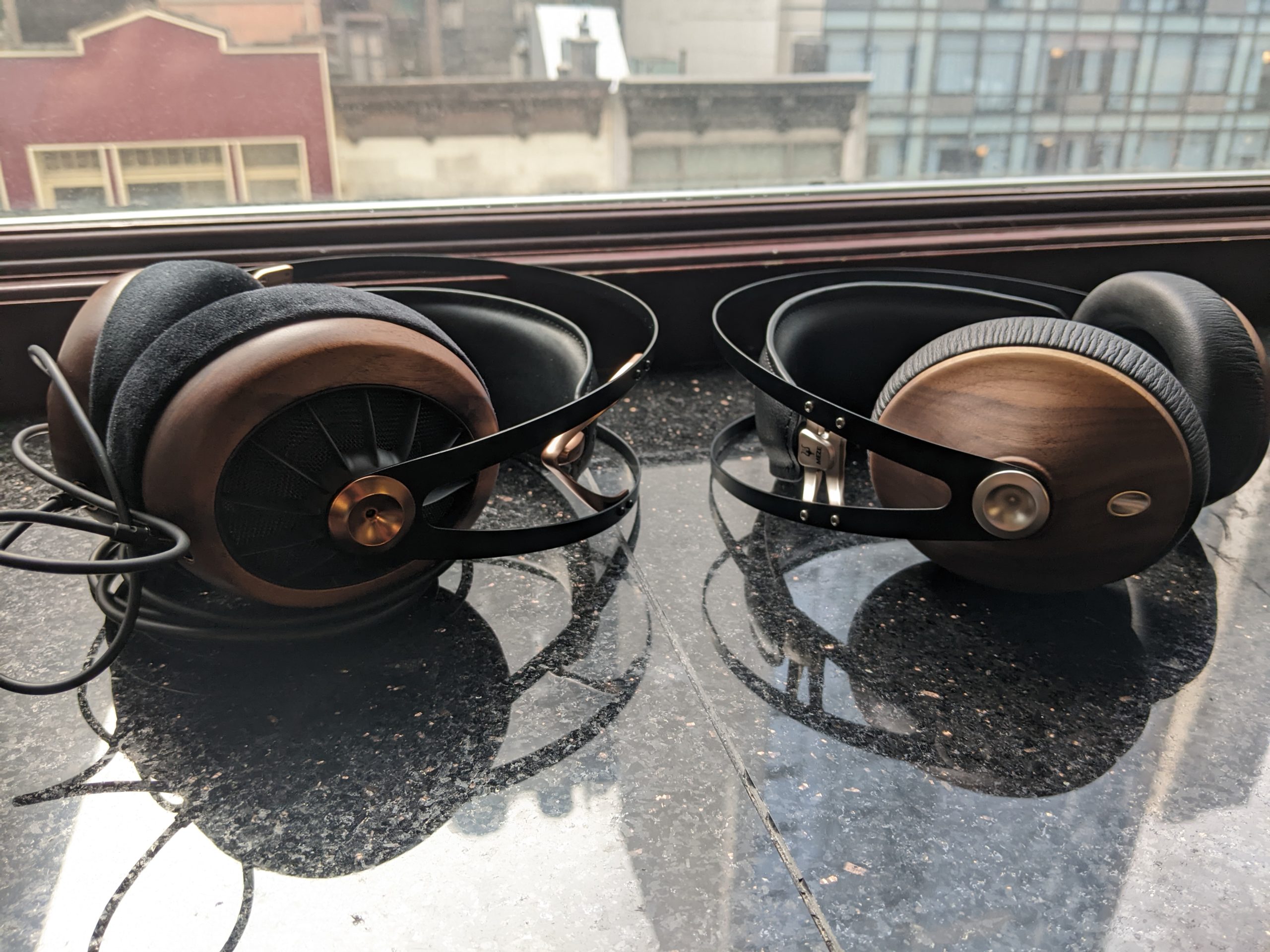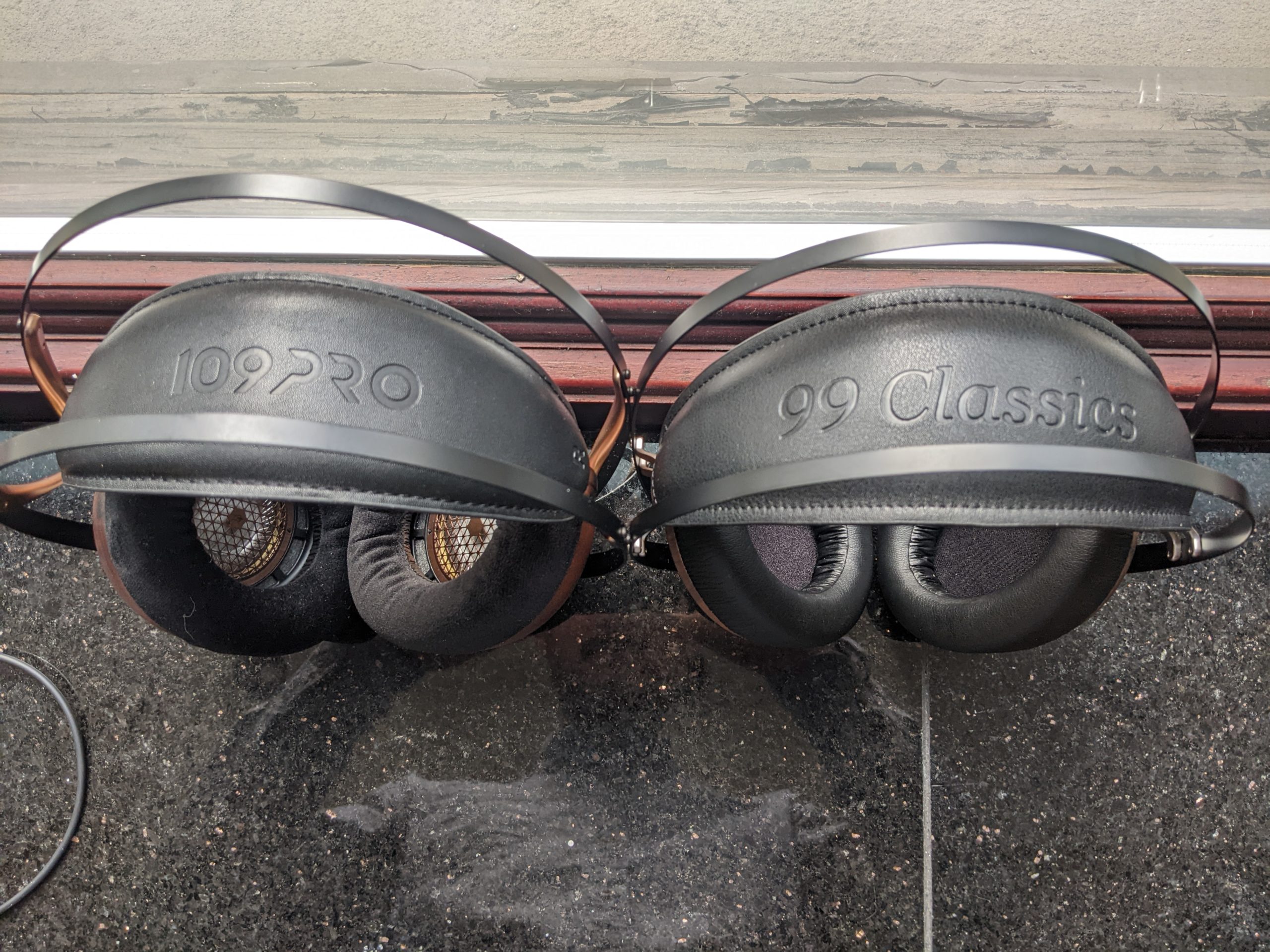Meze 109 Pro vs. Meze 99 Classics Review
Whether or not the same is the case for their technical design elements, Meze’s 109 Pro at least looks a whole lot like an open-back version of the Meze 99 Classics, and has a lot of people wondering just how similar the two are to one another. We’re dealing with a pretty significant price difference here, with the 109 Pro currently going for $799 and the 99 Classics for $309. It should come as no surprise that the 109 Pro is a more refined headphone than the 99 Classics, the real question is: how much better is it, and is the price jump worth it?
What’s in the Box?
| Meze 99 Classics | Meze 109 Pro |
|
|
Look and Feel

As you can likely see for yourself, it’s fairly apparent that the two headphones look strikingly similar. The 99 Classics are offered in both maple and walnut housing varieties and the 109 Pro exclusively in walnut. Both are genuinely elegant, unique, and standout a step above most other headphones in the style department. If I had to nitpick, I might mildly prefer the more rustic and “organic” wooden design of the 109 Pro over the more smoothed over wooden look of the 99 Classics. This is a small detail, and just my personal taste.
When it comes to fit, more notable differences start to emerge. Though the 109 Pro is significantly heavier at 375 grams compared to the 99 Classics’ 260 grams, I think most would agree that the 109 Pro is the decisive winner when it comes to comfort. The 99 Classics are fairly comfortable, but the 109 Pro is exceptionally comfortable with its velour ear pads and spacious chamber that sat the drivers fairly far from my ears. The 99 Classics have a somewhat cheap vegan leather for their default padding, which isn’t necessarily uncomfortable, but didn’t leave a particularly comfortable impression on me either. The main drawback of the 99 Classics was that my fairly small ears were pressing up against the speakers rather than resting airily as they did with the 109 Pro. This will likely annoy some more than others.
However, I give both high marks for carefully calibrated suspension headbands and clamp pressures, and would qualify both as very comfortable pairs of headphones.
Technical Design
Like I said at the beginning of the review, these two Meze’s may look quite similar, but have significant design differences. Besides the quantitative specs listed below, the 109 Pro outshines the 99 Classics with its rigid and lightweight dual composite diaphragm composed of Beryllium-coated polymer, cellulose-carbon fiber composite and copper zinc alloy. Further enhancing its technical design is its W shaped dome that contributes to more accurate high-frequency reproduction, and a ring shaped stabilizer made of copper-zinc alloy that improves absorption and reduces resonance. If that wasn’t enough, there’s one more element worth mentioning: an incredibly thin, 22 micron, Beryllium-coated semi crystalline polymer torus surrounding the W shaped dome that increases the stiffness and durability of the driver while maintaining a speedy transient response time.
| Meze 99 Classics | Meze 109 Pro |
|
|
Sound Stage
While there is a noticeable difference in size that favors the open-back 109 Pro, the difference was surprising not as drastic as I though it would be. Something the 99 Classics definitely have going for them is a pretty great depth for a pair of closed-backs at their price point – I even briefly checked to make sure music wasn’t playing out loud from my phone when the fade-in of my first test track “I’m On Fire” by the Chromatics started. If there’s anything besides looks these two have in common, I would argue its the shape of their image. The 109 Pro also has an impressive depth, though outdoes the 99 Classics by taking that depth further as well as producing some “behind-the-shoulder” sensations, making it’s stage what I would describe as 270 degrees compared to the 99 Classics more insulated and forward-facing 150 degree shape. 109 Pro wins again in terms of its exceptionally fluid, smooth, liquid-like imaging that makes for more convincing spatial dynamics.
Lows and Low Mids
Though the 109 Pro certainly makes its case in it’s imaging and staging, its balance is where the most drastic upgrades start to emerge. The Meze 99 Classics have a louder and broadly boosted low end that gives them a thicker sound signature – an emphasis that was most noticeable to me in not just the subs and mid bass, but particularly in the low mids. The roll off from this low end boost happens so late that it even seems tug the center mids up with it as well. While this can at times simply be a fun, driving sound, it also sometimes resulted in a boxy character that the rest of the mids profile failed to offset (and likely even contributed to).
The 109 Pro, on the other hand, is more balanced and decongested. Subs and mid bass are tastefully present, and can produce a surprisingly clean and powerful rumble when a mix demands it. Center mids find a very soft boost that I only started to notice after listening to a number of tracks. This low mid boost gelled well with flat center mids and particularly emphatic highs to add a warmth flourish to crisp and airy vocals. The 99 Classics may have a louder low end, but the 109 Pro is undeniably more defined and handles its low end (and mids) with much more control.
High Mids and Highs
As is frequently the case with thick, driving sound signatures, the Meze 99 Classics feature enough highs mids and low/mid treble to preserve a sense of realism, but don’t really have much high frequency personality: they clearly define their sound character in their mids and low end. The Meze 109 Pro, on the other hand, bursts into action in its high mids and highs. It’s a snappy, clean, and detailed listening experience. High pitched percussion such as hand claps snaps, and the fast decay on snare drums deliver an impactful and heady sensation and instruments like guitars are rich with bright, clean harmonic characters. I particularly appreciated how the 109 Pro handled sibilants, as it seemed to artfully play with them rather than cutting them, which seemed to provide more freedom for vocal air and clicky, intimate mouth details. Honestly, there’s no competition in the high end; it’s mostly what is responsible for making the Meze 109 Pro a very impressive headphone.
Overall
I share the love for the Meze Classics along with many people, but the 109 Pro blows them out of the water. The question is: is it worth paying $799 instead of $309? My answer to that question is a definitive yes. Comparison to the 99 Classics aside, the Meze 109 Pro has an excellent value that beats out most headphones like it price point. The 99 Classics are fun and casual, but when it’s time to get serious, the 109 Pro is the way to go.
| Meze 99 Classics | Meze 109 Pro |
|
|
The Meze 99 Classics and the Meze 109 Pro are both available for purchase from Audio46.
Compare the ranking of various headphones, earbuds and in-ear monitors using our tools.
Discuss this, and much more, over on our forum.
---MAJORHIFI may receive commissions from retail offers.















